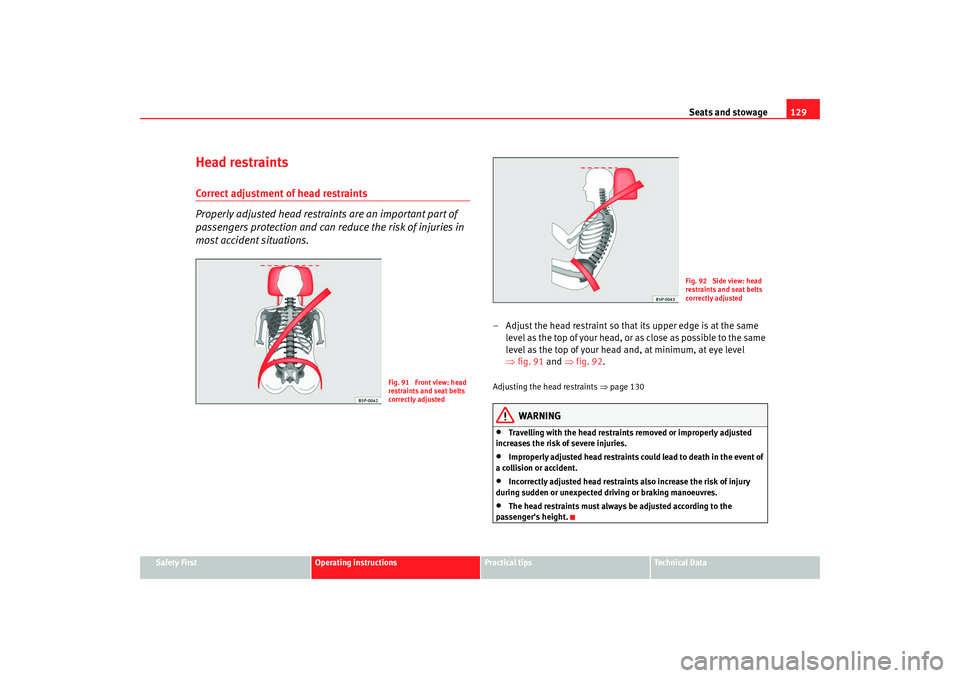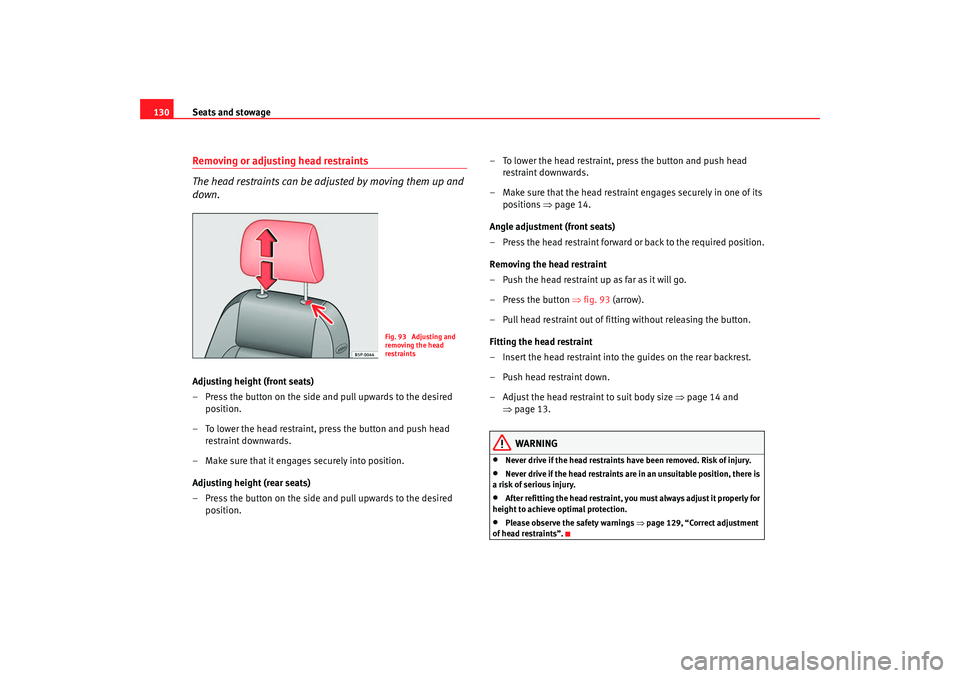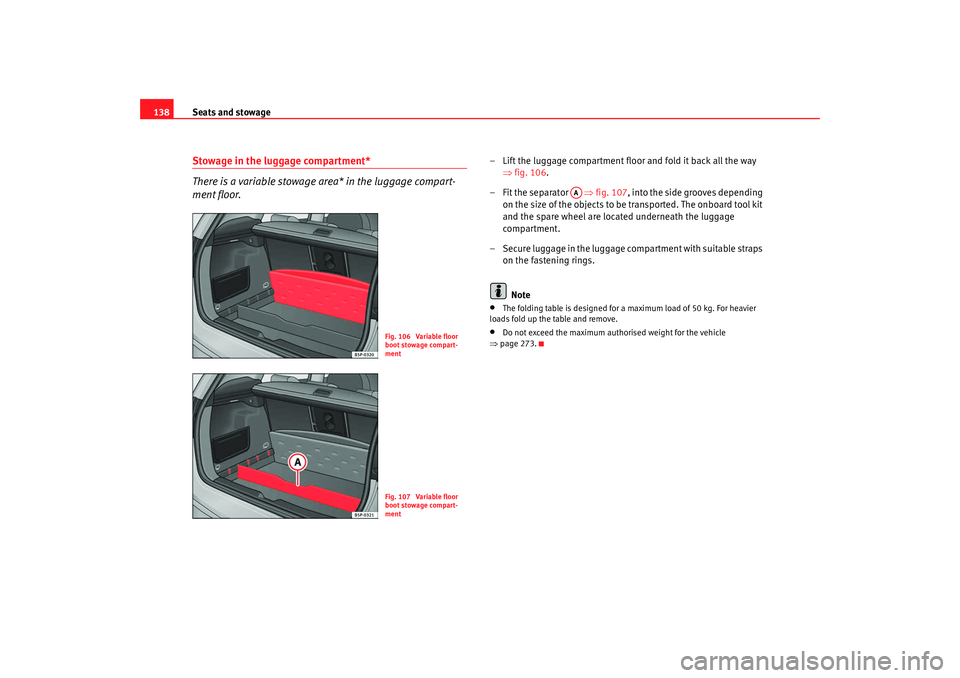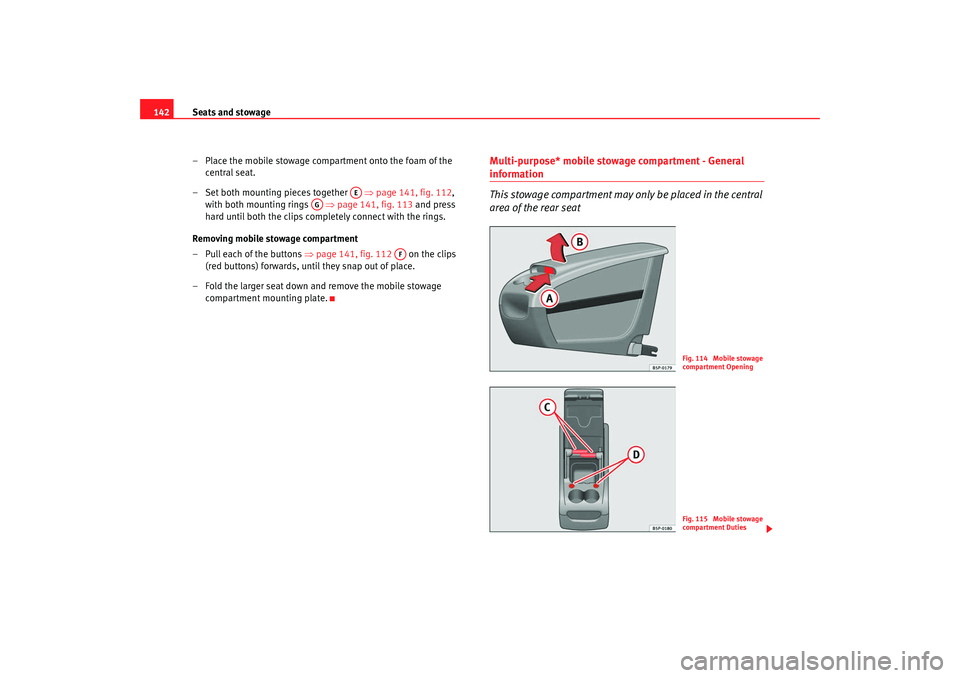2009 Seat Altea XL remove seats
[x] Cancel search: remove seatsPage 14 of 297

Safe driving13
Safety First
Operating instructions
Practical tips
Te c h n i c a l D a t a
Correct adjustment of front seat head restraints
Properly adjusted head restraints are an important part of
passengers protection and can reduce the risk of injuries in
most accident situations.
Adjust the head restraint properly in order to achieve maximum
protection.
– Adjust the head restraint so that its upper edge is at the same
level as the top of your head or as close as possible to the same
level as the top of your head and, at the very least, at eye level
⇒fig. 3 and ⇒ fig. 4Adjusting the head restraints ⇒page 128.
WARNING
•
Travelling with the head restrain ts removed or improperly adjusted
increases the risk of severe injuries.
•
Incorrectly adjusted head restraints could result in death in the event of
a collision or accident.
•
Incorrectly adjusted head restraints also increase the risk of injury
during sudden or unexpected driving or braking manoeuvres.
•
The head restraints must always be adjusted according to the
passenger's height.
Headrests in use*Vehicle occupants are pressed into their seats during a rear end collision. The
resulting body pressure on the backrest activates the crash-active head
restraint* on the front seat, which moves rapidly forwards and upwards at the
same time. This movement reduces the distance between the occupant's
head and the head rest, thus reducing the risk of head injuries such as brain
trauma.
Fig. 3 Properly adjusted
head restraint viewed
from the frontFig. 4 Properly adjusted
head restraint viewed
from the side
AlteaXL_EN.book Seite 13 M ontag, 2. Februar 2009 12:26 12
Page 28 of 297

Seat belts27
Safety First
Operating instructions
Practical tips
Te c h n i c a l D a t a
– Press the upper part of the shoulder belt guide and hold it in this
position ⇒page 26, fig. 17 .
– Move the shoulder belt guide up or down until you have adjusted the seat belt ⇒page 24.
– After adjusting, pull the shoulder belt sharply to check that the catch on the shoulder belt guide is engaged securely.Incorrectly fastened seat belts
Incorrectly worn seat belts can cause severe injuries.Seat belts can provide optimal prot ection only if the belt web is
properly worn. The seat belts must be fastened exactly in the order
described in this chapter. An in correct sitting position impairs
substantially the protection a seat belt offers and can lead to severe
or fatal injuries. The risk of severe or fatal injuries is especially
increased when a deploying airbag strikes an occupant who has
assumed an incorrect sitting position. As driver, you are responsible
for all vehicle occupants, especially children. Therefore:
– Never permit anyone to assume an incorrect sitting position in
the vehicle while travelling ⇒.
WARNING
•
An incorrectly worn seat belt incr eases the risk of severe injuries.
•
Before every trip, instruct your passengers to adjust their seat belts
properly and to wear them during the trip.
•
Read and always observe information and warnings concerning the use
of seat belts ⇒page 22.
Belt tension devicesFunction of the belt tension device
During a frontal collision, the seat belts on the front seats are
retracted automatically.The seat belts for the front occupants are equipped with belt tension devices.
Sensors will only trigger the belt tension devices during severe head-on,
lateral and rear collisions, and only if th e seat belt is actually being worn. This
retracts and tightens the seat belts, reducing the forward motion of the occu-
pants.
The belt tension device can be triggered only once.
The belt tension devices will not be triggered in the event of a light frontal,
side or rear collision, if the vehicle overturns, or in situations where no large
forces act on the front, side or rear of the vehicle.
Note
•
If the belt tension devices are triggered, a fine dust is produced. This is
normal and it is not an indication of fire in the vehicle.
•
The relevant safety requirements must be observed when the vehicle or
components of the system are scrapped. A qualified workshop is familiar with
these regulations and will be pleased to pass on the information to you.
Service and disposal of belt tension devicesThe belt tension devices are components of the seat belts that are installed
in the seats of your vehicle. If you work on the belt tension devices or remove
and install parts of the system when performing other repair work, the seat
AlteaXL_EN.book Seite 27 M ontag, 2. Februar 2009 12:26 12
Page 38 of 297

Airbag system37
Safety First
Operating instructions
Practical tips
Te c h n i c a l D a t a
hold the passengers on the front seats and the outer rear seats in a position
where the side airbags can provide maximum protection.
The airbag system is not a substitute for seat belts, but it is an integral part
of the vehicle's overall passive safety system. Please bear in mind that the
airbag system can only work effectively when the occupants are wearing their
seat belts. Therefore, it is most important to wear the seat belts at all times,
not only because this is required by la
w in most countries, but also for your
safety ⇒page 19, “Brief Introduction”.
The side airbag system will not be triggered if:
•
the ignition is switched off,
•
there is a minor side collision,
•
there is a frontal collision,
•
there is a rear-end collision,
•
the vehicle turns over.
The main parts of the airbag system are:
•
an electronic control and monitoring system (control unit),
•
The front side airbags in the backrests of the front seats and the rear side
airbags in the lining of the rear wheel housing.
•
a warning lamp
in the dash panel insert ⇒page 30.
The airbag system operation is monito red electronically. The airbag warning
lamp will light up for approx. 4 seconds every time the ignition is switched on
(self-diagnosis).
WARNING
•
In a side-on collision, the side air bags will not work, if the sensors do
not correctly measure the pressure incr ease on the interior of the doors,
due to air escaping through the areas with holes or openings in the door
panel.
•
Never drive the vehicle if the interior panels have been removed.
•
Never drive if the interior door pane ls have been removed or if the
panels have not been correctly fitted.
•
Never drive the vehicle if the loudspeakers in the door panels have
been removed, unless the holes left by the loudspeakers have been
correctly closed.
•
Always check that the openings are closed or covered if loudspeakers
or other equipment are fitted in the interior door panels.
•
Any work carried out to the doors should be made in a qualified author-
ised workshop.
•
The seat belts and airbags can only provide maximum protection if the
occupants are seated correctly ⇒page 10, “Proper sitting position for
occupants”.
•
If a fault has occured in the airbag system, have the system checked
immediately by a qualified workshop. Ot herwise, during a side collision,
the system may fail to trigger, or not trigger correctly.WARNING (continued)
AlteaXL_EN.book Seite 37 M ontag, 2. Februar 2009 12:26 12
Page 130 of 297

Seats and stowage129
Safety First
Operating instructions
Practical tips
Te c h n i c a l D a t a
Head restraintsCorrect adjustment of head restraints
Properly adjusted head restraints are an important part of
passengers protection and can reduce the risk of injuries in
most accident situations.
– Adjust the head restraint so that its upper edge is at the same
level as the top of your head, or as close as possible to the same
level as the top of your head and, at minimum, at eye level
⇒fig. 91 and ⇒ fig. 92.Adjusting the head restraints ⇒page 130
WARNING
•
Travelling with the head restrain ts removed or improperly adjusted
increases the risk of severe injuries.
•
Improperly adjusted head restraints could lead to death in the event of
a collision or accident.
•
Incorrectly adjusted head restraints also increase the risk of injury
during sudden or unexpected driving or braking manoeuvres.
•
The head restraints must always be adjusted according to the
passenger's height.
Fig. 91 Front view: head
restraints and seat belts
correctly adjusted
Fig. 92 Side view: head
restraints and seat belts
correctly adjusted
AlteaXL_EN.book Seite 129 M ontag, 2. Februar 2009 12:26 12
Page 131 of 297

Seats and stowage
130Removing or adjust ing head restraints
The head restraints can be adjusted by moving them up and
down.Adjusting height (front seats)
– Press the button on the side and pull upwards to the desired position.
– To lower the head restraint, press the button and push head restraint downwards.
– Make sure that it engages securely into position.
Adjusting height (rear seats)
– Press the button on the side and pull upwards to the desired position. – To lower the head restraint, press the button and push head
restraint downwards.
– Make sure that the head restrain t engages securely in one of its
positions ⇒page 14.
Angle adjustment (front seats)
– Press the head restraint forward or back to the required position.
Removing the head restraint
– Push the head restraint up as far as it will go.
– Press the button ⇒fig. 93 (arrow).
– Pull head restraint out of fitting without releasing the button.
Fitting the head restraint
– Insert the head restraint into the guides on the rear backrest.
– Push head restraint down.
– Adjust the head restraint to suit body size ⇒page 14 and
⇒ page 13.
WARNING
•
Never drive if the head restraints have been removed. Risk of injury.
•
Never drive if the head restraints are in an unsuitable position, there is
a risk of serious injury.
•
After refitting the head restraint, yo u must always adjust it properly for
height to achieve optimal protection.
•
Please observe the safety warnings ⇒page 129, “Correct adjustment
of head restraints”.
Fig. 93 Adjusting and
removing the head
restraints
AlteaXL_EN.book Seite 130 M ontag, 2. Februar 2009 12:26 12
Page 139 of 297

Seats and stowage
138Stowage in the luggage compartment*
There is a variable stowage area* in the luggage compart-
ment floor.
– Lift the luggage compartment floor and fold it back all the way
⇒fig. 106.
– Fit the separator ⇒fig. 107, into the side grooves depending
on the size of the objects to be transported. The onboard tool kit
and the spare wheel are located underneath the luggage
compartment.
– Secure luggage in the luggage compartment with suitable straps on the fastening rings.
Note•
The folding table is designed for a maximum load of 50 kg. For heavier
loads fold up the table and remove.
•
Do not exceed the maximum authorised weight for the vehicle
⇒ page 273.
Fig. 106 Variable floor
boot stowage compart-
mentFig. 107 Variable floor
boot stowage compart-
ment
AA
AlteaXL_EN.book Seite 138 M ontag, 2. Februar 2009 12:26 12
Page 140 of 297

Seats and stowage139
Safety First
Operating instructions
Practical tips
Te c h n i c a l D a t a
Luggage compartment retaining net
There is a retaining net in the luggage compartment for
securing objects.– Use the fastening rings located on the side of the luggage
compartment to attach the retaining net ⇒fig. 108.
Note•
The folding table is designed for a maximum load of 50 kg. For heavier
loads fold up the table and remove.
•
Do not exceed the maximum authorised weight for the vehicle
⇒ page 273.
Other stowage areasOther stowage areas can be found:•
in the centre console,
•
in the door trims (front and rear),
•
in the side trims of the luggage compartment,
•
in the spare wheel recess in the luggage compartment (only on vehicles
with an optional anti-puncture kit*.
The clothes hooks are located on the rear roof handles.
WARNING
•
Do not store loose objects on the dashboard. These objects could be
flung through the passenger compartment when the vehicle is moving (e.g.
while accelerating, braking or cornering) and distract the driver. Risk of
accident.
•
Ensure that no objects can fall from the centre console or other stowage
areas into the driver foot well while the vehicle is moving. In the event of a
sudden braking manoeuvre, you will not be able to use the brake, clutch or
accelerator. Risk of accident.
•
Clothing hung on the coat hooks must not restrict the driver's view.
Risk of accident. The coat hooks are intended only for use with light arti-
cles of clothing. Do not leave any hard, sharp or heavy objects in hanging
articles of clothing. During sudden br aking manoeuvres or accidents, espe-
cially those involving airbag deployment, these objects could injure the
vehicle occupants.
Fig. 108 Retaining net
AlteaXL_EN.book Seite 139 M ontag, 2. Februar 2009 12:26 12
Page 143 of 297

Seats and stowage
142
– Place the mobile stowage compartment onto the foam of the central seat.
– Set both mounting pieces together ⇒page 141, fig. 112 ,
with both mounting rings ⇒page 141, fig. 113 and press
hard until both the clips completely connect with the rings.
Removing mobile stowage compartment
– Pull each of the buttons ⇒page 141, fig. 112 on the clips
(red buttons) forwards, until they snap out of place.
– Fold the larger seat down and remove the mobile stowage compartment mounting plate.
Multi-purpose* mobile stowage compartment - General information
This stowage compartment may only be placed in the central
area of the rear seat
AE
AG
AF
Fig. 114 Mobile stowage
compartment OpeningFig. 115 Mobile stowage
compartment Duties
AlteaXL_EN.book Seite 142 M ontag, 2. Februar 2009 12:26 12